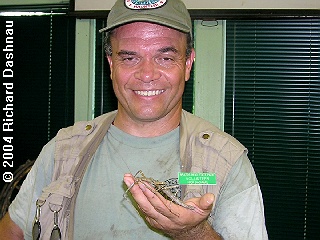
That's me with the giant walking stick (06/20/2004). This page features mantids.
Go back to my home page, Welcome
to rickubis.com
Go
back to the RICKUBISCAM page.
----------------------------------
That's me with the giant
walking stick (06/20/2004). This page features mantids.
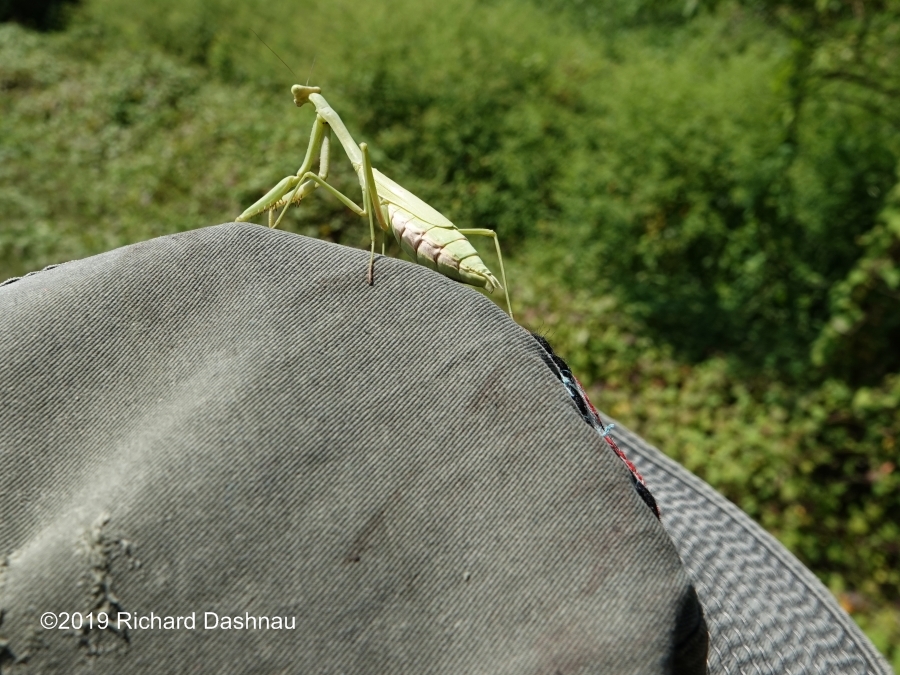
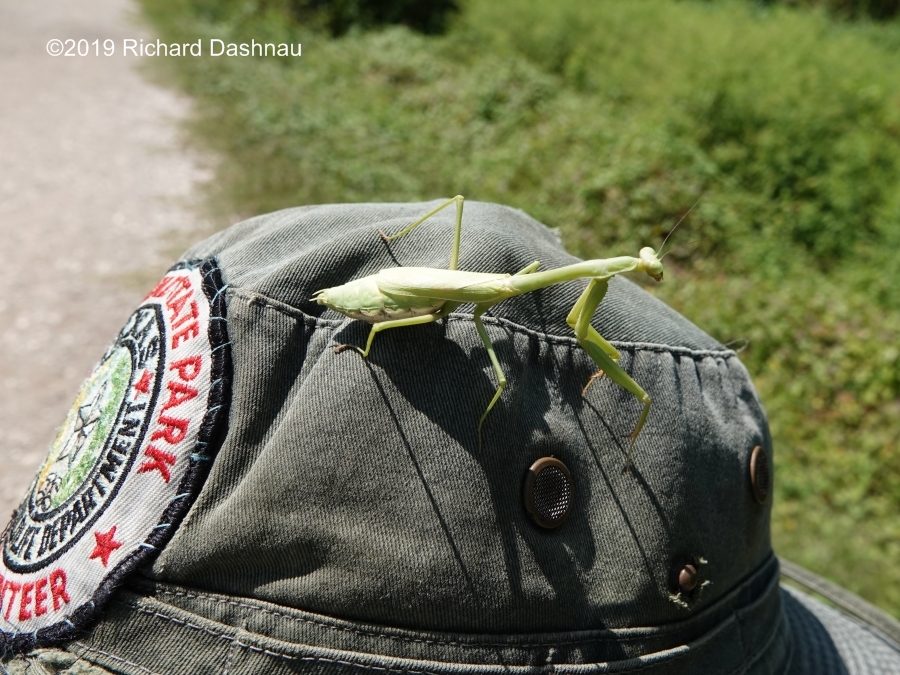
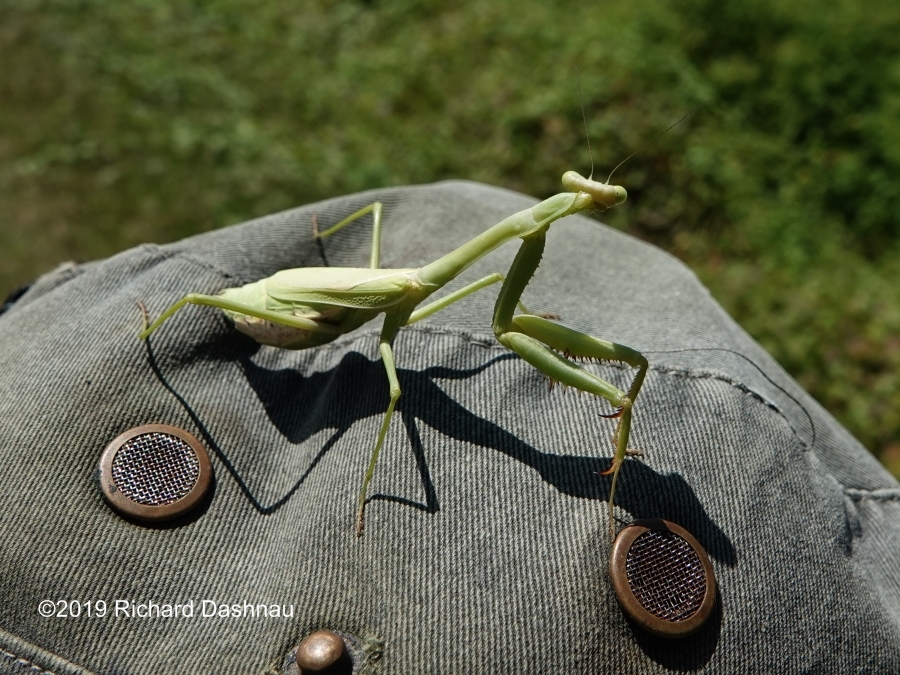
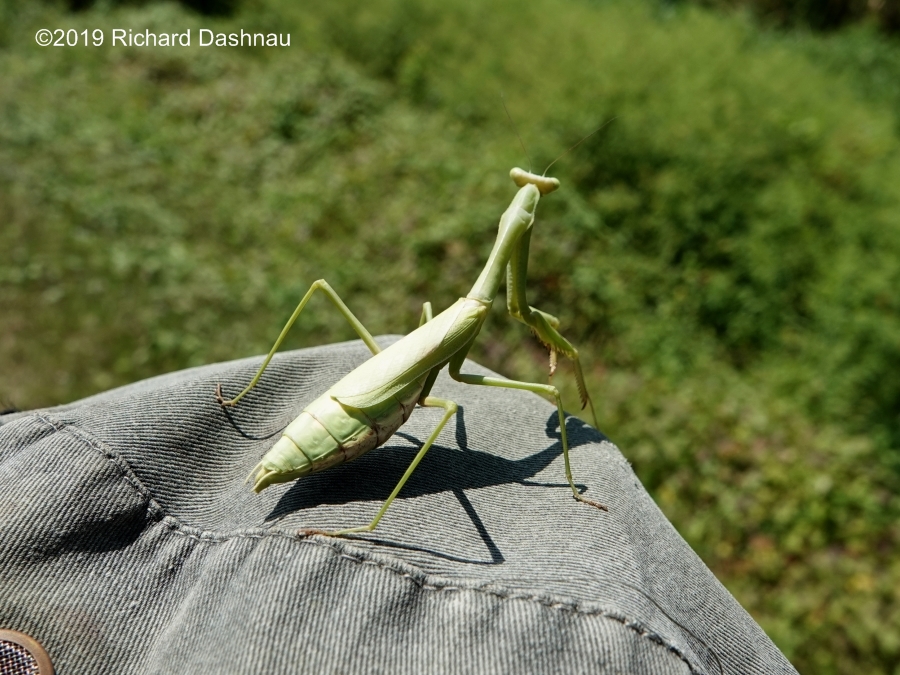
---------------------------------------------------------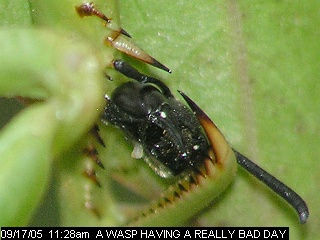
BAD DAY
The
first image shows the mantis waiting (see IN REPOSE, below). While we're
watching, take a closer look at the positioning of the forelegs, especially
the long, clawed foot folded up
against the claws (see SHEATHED WEAPONS,
and FEET IN LINE, below). We'll be looking at those again a bit later.
I was taking more shots (see FULL REPOSE SHOT, below), when
I noticed movement
in the background. It was a wasp feeding on the flowers. The mantis noticed
it, too, and began to stalk it.
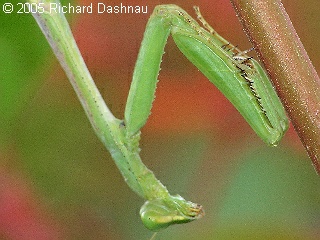 -
-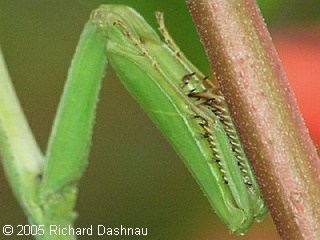 -
-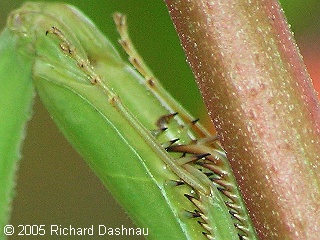 -
-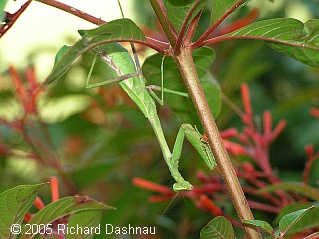 -
-
IN
REPOSE
SHEATHED WEAPONS
FEET IN LINE WITH
FORELEGS
FULL REPOSE
SHOT
The next images (BEGINNING THE HUNT, below) are frames from a VIDEO
CLIP 19.3mb. The stalking shows
the absolute body control the mantis has as it begins stalking its prey.
I remained
behind the mantis so I wouldn't scare it, or its potential food.The
next image below (see STALKING MANTIS) is a frame from the same clip, showing
the end of this brief hunt. Since the
mantis was occupied, I was
able to come around and film a better angle. The next image (see TIME TO
EAT, below) is a frame from the clip showing the beginning of
the meal. The
immobilized wasp tried to fight back with its stinger as
the mantis began chewing through its abdomen, as shown in the image below
(FUTILE COUNTERATTACK) which is a frame from the
video clip. Watch the
clip closely and you'll see the stinger extend a few times and bounce off
the mantid's armored foreleg.
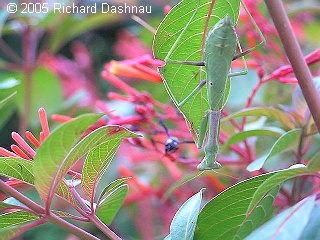
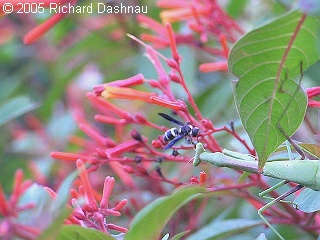 -
-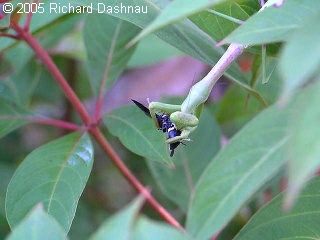 -
-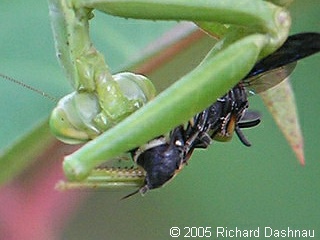 --
--
BEGINNING THE HUNT
STALKING
MANTIS
TIME TO EAT
FUTILE COUNTERATTACK
The mantis continued chewing through the abdomen as shown below in DISARMING THE WASP, a frame from the video clip, and OR JUST EATING?, cropped from a full size photo.
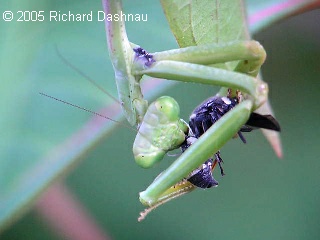
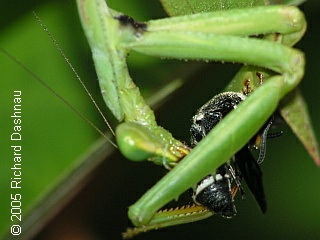
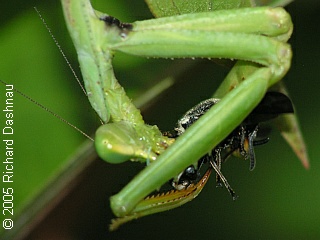
DISARMING THE
WASP?
... OR JUST EATING?
STINGER GONE
While
it's eating, notice the amazing range of motion shown by the movements
of the mantid's head. Eventually, the rear of the abdomen--with the stinger--fell
off (see STINGER GONE,
above). While watching the mantis eat, I was also
fascinated by the intricate movement of the little feelers around the mantid's
mouthparts--they are called "labial palps and maxillary palps"
according
to my Audubon Field Guide to Insects and Spiders. (see MOUTHPARTS AT WORK,
and MOUTHPARTS CLOSER, below). The mantis kept eating, chewing its way
up the wasp,
from the EMPTY ABDOMEN (below) and working UP THE THORAX (below).
-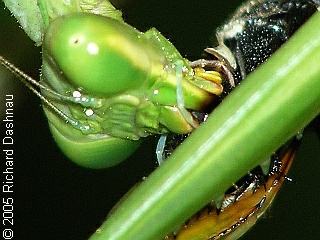 -
-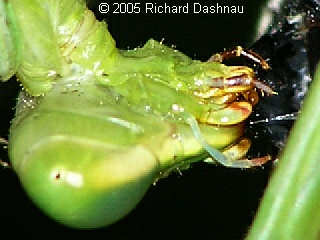 -
-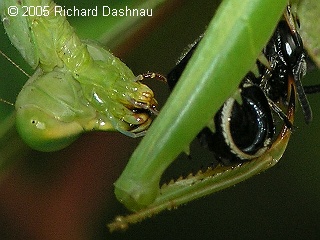 -
-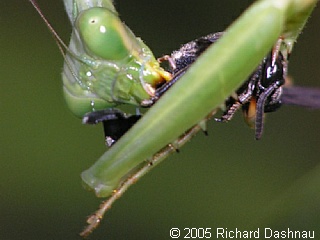
OUTHPARTS AT WORK
MOUTHPARTS
CLOSER
EMPTY ABDOMEN
UP THE THORAX
From
time to time, the mantis would move its head away from the wasp to work
on a single piece. In GET EVERY BIT below, another frame from a video clip,
it uses its two sets of palps to
move a scrap of shell around to chew off
the flesh before dropping it. The palps seem to work sort of like built-in
chopsticks. While I was looking over my photos (about 160 or so along with
short video clips) I noticed that the "forearm" claws were bare. That is,
the front leg was not visible or interfering with their use. That's when
I noticed that the "leg" section of the foreleg claw
was now folded back
out of the way! What a chillingly efficient machine! (see FEET SWUNG AWAY, below).
Compare that with the FEET IN LINE picture above. In the picture above,
the feet
point away from the claw hinge, while below they point towards
it.
The
mantis then chewed its way through the thorax (see WASP AND MANTIS, OTHER
WHITE MEAT, and THE THORAX
GOES, below).
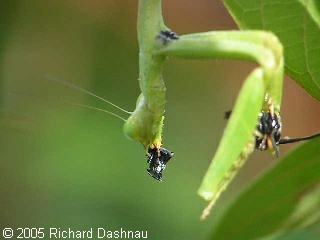 -
-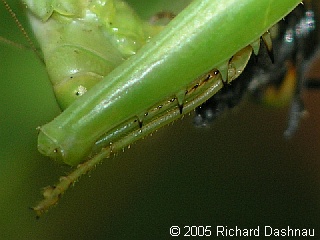 -
-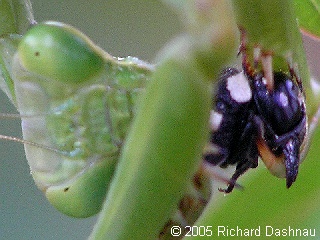 -
-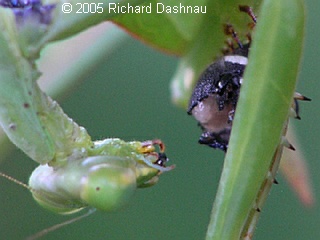 -
-
GET EVERY BIT
FEET SWUNG AWAY FROM
FORELEGS
WASP AND MANTIS
AH!
THE OTHER WHITE MEAT
Finally,
all that was left was the wasp's head, which was also devoured. (see JUST
THE HEAD IS LEFT, below. A cropped section of the full-sized image--the
head nonchalantly held in one
claw while the mantis cleans the other--is
today's RICKUBISCAM image.)
I noticed
slight movements of the wasp's antennae as it was being devoured. (see
AND NOW THE HEAD, and
GOODBYE, WASP!, below) This was probably reflex activity,
but still, I wonder. Would the wasp's eyes still be feeding information
to its brain? Would the wasp be watching itself being eaten
a bit at a
time? Then would that finally stop when the mantis devoured its brain...and
the rest of the wasp's head? How's that for a creepy thought?
This was one of those lucky opportunities,
and some of my pictures actually
came out well!

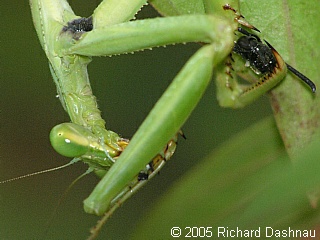
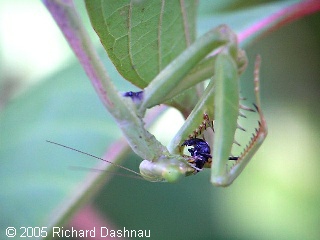 -
-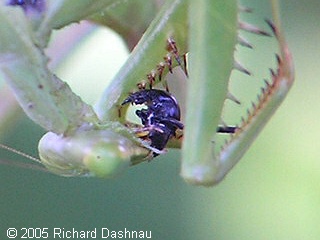 -
-
THE THORAX GOES
JUST THE HEAD IS LEFT
AND NOW THE HEAD GOES
GOODBYE, WASP!
August
21, 2005-- Since I saw the small praying
mantids a few weekends ago (see July 24 below), I've been looking for them
in the same bushes. I had no luck until today. I almost missed it,
but
was able to recognize the "elbow"--which I think is the joint between the
"lower coxa" and the "femur"--of a mantis hidden among the leaves. I slowly
moved in and took a few pictures. The
mantis, almost perfectly hidden,
is today's Rickubiscam photo.
I believe
many people are fascinated by this insect and its elegant form. The first
image below (HANGING AROUND FOR A
MEAL) shows the entire mantis among the
leaves. I was a bit surprised at the size of this mantis, considering the
small size of the ones I saw a few weekends ago. To give some scale, I
slowly placed my hand under the mantis and very carefully moved it near
the insect. The next image (WAS THAT THERE BEFORE?, below) shows it near
my hand. Pretty big, eh? The next
image is a closeup of the mantid's attack
and defence system. (see DEADLY SPIKES, below) The mantis does, of course
use these claws (specifically the two segments are the "tibia"--near
the
end--and the "femur" nearer the body.) for attacking its prey; but I know
from personal experience that they will also use their forelegs for defense
(one got me when I was younger).
I moved
my hand a little more, and the mantis (still young, judging by the underdeveloped
wings) climbed onto my hand! The next image shows it resting comfortably
there.(see THUMB BIG
INSECT, below).
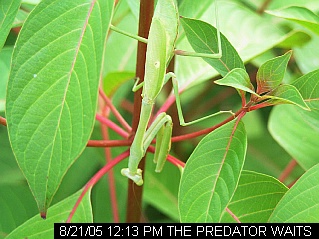
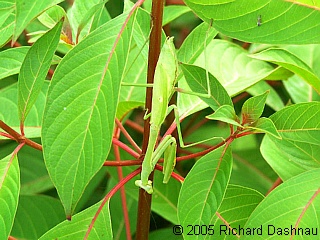 -
-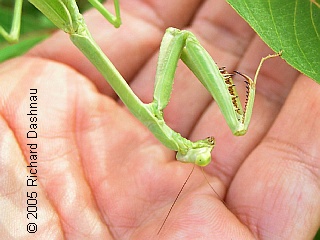 -
-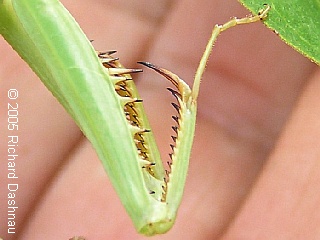 -
-
HANGING AROUND FOR A MEAL
WAS THAT
THERE
BEFORE?
DEADLY
SPIKES
While
I was enjoying this visit, I was able to shoot a short video
clip(2.7mb). the next image (MANTIS ON HAND, below) shows a frame from
this clip which shows it jumping off my hand.
Then
I remembered that I have a folding ruler. I coaxed the mantis onto it just
one time, and was able to shoot another short movie
clip(2.7mb) as it went off in peace. The last image (I'M
PRETTY BIG,
RIGHT?, below) is a frame from that clip. This *immature* mantis is almost
3 inches long!
----------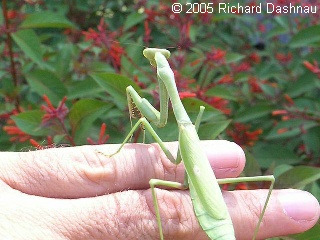 --------------
--------------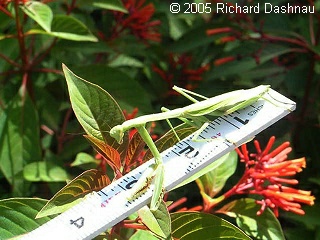
MANTIS ON MY
HAND!
I'M PRETTY BIG, RIGHT?
SHORT VIDEO CLIP O1 2.7mb
SHORT VIDEO CLIP O2 2.7mb
I did
a little research ( in my Audubon Field Guide to Insects and Spiders, and
some on the internet of course), and discovered that our big mantids are
not native to the U.S.!
This
one is probably a European Mantis (Mantis Religiosa), because it has "black
spots underneath its fore coxa". The spots are not visible here, but in
an earlier part of one of the clips, I
can see the spots. According to
the Audubon book, these were "accidentally introduced in 1899 on nursery
stock from southern Europe.
I can't
imagine living here and NOT being able to
encounter a beautiful mantis
like this one.
Mantids
(I see this as a plural for "mantis") are ravenous predators and evidently
will attack and eat almost anything--including hummingbirds. An
earlier
version of the Texas Parks and Wildlife magazine (last year sometime...maybe)
featured an excellent photo of a mantis which had caught a hummingbird.
A search of the internet
brought to light some links which evidently show
that this is not impossible. Imagine that! A bird-eating insect living
here in the U.S.!
The
links: Link
1 Link 2 Link
3
July
24, 2005-- It's amazing how much you
can see right around the Visitor's Center (Nature Center) at Brazos Bend
State Park if you just look. Chuck and I were walking around the building,
looking for spiders and insects. Chuck pointed out a small Praying Mantis
on the wall which was almost the same color as the paint. He got it to
walk onto a twig, and from there I got it to jump
on my hand. It moved
too quickly for a picture, and it ran up my arm, my neck, and onto the
top of my hat. I took my hat off and shot the picture just below.
-----------------------------------------------------------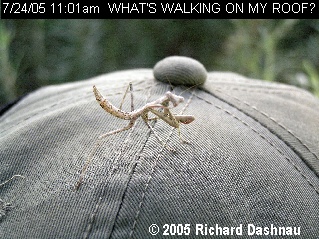
TAPPING
ON MY LID
I've
always thought Mantids were fascinating. A further search of some plants
in the garden revealed a couple more of these insects. I took a few pictures
on the 24th, and was able to find a
mantis to shoot the next weekend, on
July 31st. The pictures below show this very attractive creature.
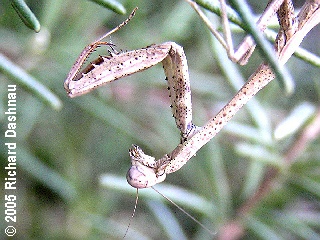 -
-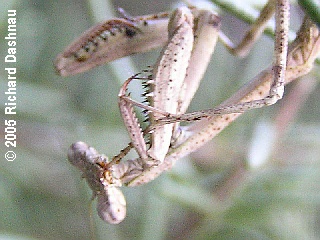 -
-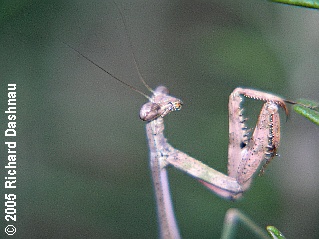 -
-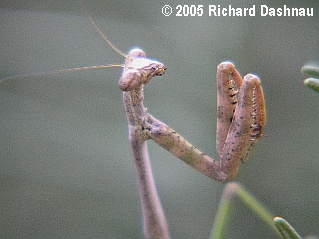 -
-
THE PREDATOR
CLEANING HIS EQUIPMENT
CHECK THESE WEAPONS!
ALERT FOR DANGER OR PREY
The last one (with my fingers) shows how small the Praying Mantis was. This size, as well as no visible developed wings show this as an immature specimen. Isn't that camouflage amazing?
If you'd like to know more about the park follow these links:Brazos Bend State Park The main page.
Brazos
Bend State Park Volunteer's Page The
volunteer's main page.
Go back to my home page, Welcome
to rickubis.com
Go
back to the RICKUBISCAM page.
Go
back to the See the World
page.